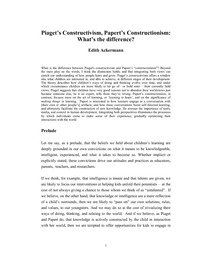Piaget’s Constructivism, Papert’s ConstructionismWhat’s the difference?
|
 |
 Diese Seite wurde seit 1 Jahr inhaltlich nicht mehr aktualisiert.
Unter Umständen ist sie nicht mehr aktuell.
Diese Seite wurde seit 1 Jahr inhaltlich nicht mehr aktualisiert.
Unter Umständen ist sie nicht mehr aktuell.
 Zusammenfassungen
Zusammenfassungen
What is the difference between Piaget's constructivism and Papert’s "constructionism"? Beyond the mere play on the words, I think the distinction holds, and that integrating both views can enrich our understanding of how people learn and grow. Piaget’s constructivism offers a windowinto what children are interested in, and able to achieve, at diffe rent stages of their development. The theory describes how children’s ways of doing and thinking evolve over time, and under which circumstance children are more likely to let go of - or hold onto - their currently held views. Piaget suggests that children have very good reasons not to abandon their worldviews just
because someone else, be it an expert, tells them they’re wrong. Papert’s constructionism, in contrast, focuses more on the art of learning, or ‘learning to learn’, and on the significance of
making things in learning. Papert is interested in how learners engage in a conversation with [their own or other people’s] artifacts, and how these conversations boost self-directed learning,
and ultimately facilitate the construction of new knowledge. He stresses the importance of tools, media, and context in human development. Integrating both perspectives illuminates the processes
by which individuals come to make sense of their experience, gradually optimizing their interactions with the world.
Von Edith Ackermann im Text Piaget’s Constructivism, Papert’s Constructionism  Dieser Text erwähnt ...
Dieser Text erwähnt ...
 Personen KB IB clear | Bärbel Inhelder , Seymour Papert , Jean Piaget , Sherry Turkle | ||||||||||||||||||||||||||||||||||||
 Begriffe KB IB clear | Konstruktionismusconstructionism , Konstruktivismusconstructivism | ||||||||||||||||||||||||||||||||||||
 Bücher |
|
 Zitationsgraph
Zitationsgraph
 Zitationsgraph (Beta-Test mit vis.js)
Zitationsgraph (Beta-Test mit vis.js)
 Zeitleiste
Zeitleiste
 8 Erwähnungen
8 Erwähnungen 
- Jahrbuch Medienpädagogik 14 (Manuela Pietraß, Johannes Fromme, Petra Grell, Theo Hug) (2017)


- 8. Design von Interaktionsräumen für reflexive Erfahrung - Wie werden im Digitalen Medium implementierte Modelle erfahr- und verstehbar (Bardo Herzig, Heidi Schelhowe, Bernd Robben, Tilman-Mathies Klar, Sandra Aßmann) (2017)


- 8. Design von Interaktionsräumen für reflexive Erfahrung - Wie werden im Digitalen Medium implementierte Modelle erfahr- und verstehbar (Bardo Herzig, Heidi Schelhowe, Bernd Robben, Tilman-Mathies Klar, Sandra Aßmann) (2017)
- Development and Evaluation of Concepts and Tools to Reinforce Gender Equality by Engaging Female Teenagers in Coding (Bernadette Spieler) (2018)


- From Embedded Systems to Physical Computing - Challenges of the Digital World in Secondary Computer Science Education (Mareen Przybylla) (2018)


- Concepts before coding - non-programming interactives to advance learning of introductory programming concepts in middle school (Shuchi Grover, Nicholas Jackiw, Patrik Lundh) (2019)


- Mobile Medien im Schulkontext (Dorothee M. Meister, Ilka Mindt) (2020)


- The turtle and the mouse - how constructivist learning theory shaped artificial intelligence and educational technology in the 1960s (Barbra Hof) (2020)


- Programming in K–6 - Understanding Errors and Supporting Autonomous Learning (Jacqueline Staub) (2021)


- Informatics in Schools. A Step Beyond Digital Education - 15th International Conference on Informatics in Schools: Situation, Evolution, and Perspectives, ISSEP 2022, Vienna, Austria, September 26–28, 2022 (Andreas Bollin, Gerald Futschek) (2022)


- Bebras Tasks Based on Assembling Programming Code (Jiří Vaníček, Václav Šimandl, Václav Dobiáš)


- Bebras Tasks Based on Assembling Programming Code (Jiří Vaníček, Václav Šimandl, Václav Dobiáš)
 Volltext dieses Dokuments
Volltext dieses Dokuments
 |  Piaget’s Constructivism, Papert’s Constructionism: Artikel als Volltext ( Piaget’s Constructivism, Papert’s Constructionism: Artikel als Volltext ( : :  , 37 kByte; , 37 kByte;  : :  2021-03-21) 2021-03-21) |
 Anderswo suchen
Anderswo suchen 
 Beat und dieser Text
Beat und dieser Text
Beat war Co-Leiter des ICT-Kompetenzzentrums TOP während er Dieser Text ins Biblionetz aufgenommen hat. Die bisher letzte Bearbeitung erfolgte während seiner Zeit am Institut für Medien und Schule. Beat besitzt kein physisches, aber ein digitales Exemplar. Eine digitale Version ist auf dem Internet verfügbar (s.o.). Aufgrund der wenigen Einträge im Biblionetz scheint er es nicht wirklich gelesen zu haben. Es gibt bisher auch nur wenige Objekte im Biblionetz, die dieses Werk zitieren.









 (
(

 Biblionetz-History
Biblionetz-History